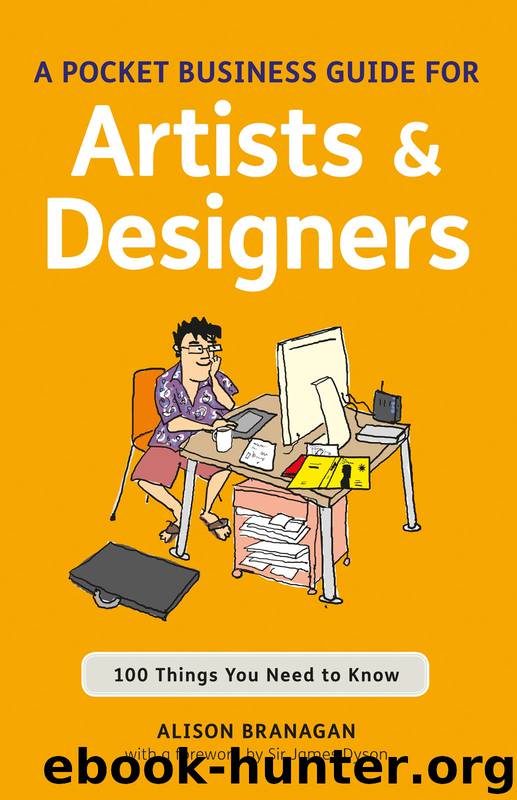Pocket Business Guide for Artists and Designers by Alison Branagan

Author:Alison Branagan
Language: eng
Format: epub
Publisher: A&C Black
Published: 2011-06-15T16:00:00+00:00
* * *
RESOURCES
www.ipo.gov.uk
www.artquest.org.uk/artlaw
www.dacs.org.uk
Copyright and unregistered design right
In the UK at the time of writing you do not need to register copyright for an artistic work. The same applies to the ‘unregistered design’ right, which is like a lazy version of copyright, but for products. Unregistered design right in the UK lasts 15 years from the first drawing or prototype, and only 10 years from the date an item is first marketed.
Retaining records
It is important to keep a properly organised archive of sketches, photographs, plans, source materials, models or early drafts. Make sure you date and sign sketches, paintings or other artworks and designs. This is essential when trying to assert your rights and prove that you are the original maker. Equally, retaining records will help you defend yourself against any allegations of copying from other artists, designers or businesses.
If you have many digital files stored in a computer or on back-up media, it is vital to print these images on paper and store them together. Remember to make use of the copyright symbol © as much as possible, such as on your website, in presentations or other proposals. If you form a good working relationship with a local intellectual property solicitor they should be prepared to hold date-stamped copies of artworks, designs and inventions on your behalf.
Registered design right
To gain protection in the market, designs including textiles/fabric patterns can be registered at the Intellectual Property Office (IPO). If your design or prototype is deemed original enough, you will be granted protection for up to 25 years, which can be renewed every five years. Please also refer to Q.25, Q.55 and the following section.
Know-how
You can simply keep particular areas of industry know-how, such as recipes or working methods, as trade secrets. Please also refer to Q.57.
Patents
You can apply to register a patent to protect novel inventions, formulas/recipes, or the processes involved in making a new material.
If you think you have an innovative idea, diagram or prototype you should not reveal it to anyone until you have spoken to an intellectual property solicitor or patent agent. Even then you should not disclose anything to anyone until your invention has been filed as an ‘initial application’ for one year (there is no fee for this). Only then can you discuss the invention openly, and exhibit your product at degree or trade shows, etc. Once a patent has been granted it can last up to 20 years.
It is essential to make use of Non-Disclosure Agreements (NDA) when speaking to potential investors, manufacturers, or, indeed, any third party.
Business, brand, product names and other marks
Business, brand and product names can be initially protected in the marketplace by using the symbol ™. These letters indicate that you are using a name as a business or brand name. To gain full protection, you must register your name as a trademark with the Intellectual Property Office (IPO). Please also refer to Q.5, Q.34 and Q.56.
Download
This site does not store any files on its server. We only index and link to content provided by other sites. Please contact the content providers to delete copyright contents if any and email us, we'll remove relevant links or contents immediately.
Things Are What You Make of Them: Life Advice for Creatives by Adam J. Kurtz(1821)
The Monuments Men by Robert M. Edsel(1743)
The Freelance Manifesto: A Field Guide for the Modern Motion Designer by Joey Korenman(1581)
Find Your Artistic Voice by Lisa Congdon(1394)
The Business of Being an Artist by Daniel Grant(1339)
101 Gag Ideas: Companion to the One Minute Caricature by James van der Keyl(1328)
Boom by Michael Shnayerson(1296)
Your Art Will Save Your Life by Beth Pickens(1250)
Your Inner Critic Is a Big Jerk by Danielle Krysa(1238)
Breakfast at Sotheby's(1199)
The Lady in Gold by Anne-marie O'connor(1197)
Seven Days in the Art World by Sarah Thornton(1186)
Create Your Art Career by Rhonda Schaller(1177)
How to Survive and Prosper as an Artist by Caroll Michels(1162)
When Talent Isn't Enough: Business Basics for the Creatively Inclined by Kristen Fischer(1115)
Need you Now (Top Shelf Romance Book 2) by unknow(1114)
33 Artists in 3 Acts by Sarah Thornton(1112)
Art Held Hostage by John Anderson(1073)
Art of the Deal by Noah Horowitz(1070)
